| This article needs additional citations for verification. Please help improve this article by adding citations to reliable sources. Unsourced material may be challenged and removed. Find sources: "Vanity Fair" American magazine 1913–1936 – news · newspapers · books · scholar · JSTOR (December 2018) (Learn how and when to remove this message) |

Vanity Fair was an American society magazine published from 1913 to 1936. It was highly successful until the Great Depression led to its becoming unprofitable, and it was merged into Vogue in 1936. In the 1980s, the title was revived.
History

Condé Nast began his empire by purchasing the men's fashion magazine Dress in 1913. He renamed the magazine Dress and Vanity Fair and published four issues in 1913. Nast paid $3,000 for the right to use the title "Vanity Fair" in the United States, granted by the magazine The Standard and Vanity Fair, "the only periodical printed for the playgoer and player", published weekly by the "Standard and Vanity Fair Company, Inc", whose president was Harry Mountford, also General Director of the White Rats theatrical union.
The magazine achieved great popularity under editor Frank Crowninshield. In 1919 Robert Benchley was tapped to become managing editor. He joined Dorothy Parker, who had come to the magazine from Vogue, and was the staff drama critic. Benchley hired future playwright Robert E. Sherwood, who had recently returned from World War I. The trio were among the original members of the Algonquin Round Table, which met at the Algonquin Hotel, on the same West 44th Street block as Condé Nast's offices. Crowninshield attracted some of the best writers of the era. Aldous Huxley, T. S. Eliot, Ferenc Molnár, Gertrude Stein, and Djuna Barnes all appeared in a single issue, July 1923.
In 1915, it published more pages of advertisements than any other U.S. magazine. It continued to thrive into the 1920s.
Starting in 1925, Vanity Fair competed with The New Yorker as the American establishment's top culture chronicle. It contained writing by Thomas Wolfe, T. S. Eliot and P. G. Wodehouse, theatre criticisms by Dorothy Parker, and photographs by Edward Steichen; Clare Boothe Luce was its editor for some time. However, it became a casualty of the Great Depression and declining advertising revenues, although its circulation, at 90,000 copies, was at its peak. Condé Nast announced in December 1935 that Vanity Fair would be merged with Vogue (circulation 156,000) as of the March 1936 issue.
1983 revival
Main article: Vanity Fair (magazine)In 1983 Vanity Fair was revived by Condé Nast Publications as a magazine of pop culture, fashion and politics.
Notes and references
- Crowninshield, Frank (3 March 1966). "Vanity fair": 45 v. in 33 – via Hathi Trust.
{{cite journal}}: Cite journal requires|journal=(help) - 1913-1922: HathiTrust has all issues through the end of 1922 in full view. (Some later volumes can be searched but not read online.)
- "Vanity Fair archives".
- Vanity Fair is a year-long fair in John Bunyan's Christian allegory The Pilgrim's Progress, where visitors are tempted with every worldly vanity.
- Ben Yagoda, About Town, New York: Scribner, 2000, p. 37.
- Yagoda, 2000, p. 36.
- Articles, Old Magazine. "Old Magazine Articles". www.oldmagazinearticles.com.
- "Vanity Fair Merged With Vogue by Nast", New York Times, p. 21, December 30, 1935
"Conde Nast Publications To Combine Two Magazines", Wall Street Journal, p. 2, December 31, 1935.
External links
 Media related to Vanity Fair (US magazine 1913–36) at Wikimedia Commons
Media related to Vanity Fair (US magazine 1913–36) at Wikimedia Commons